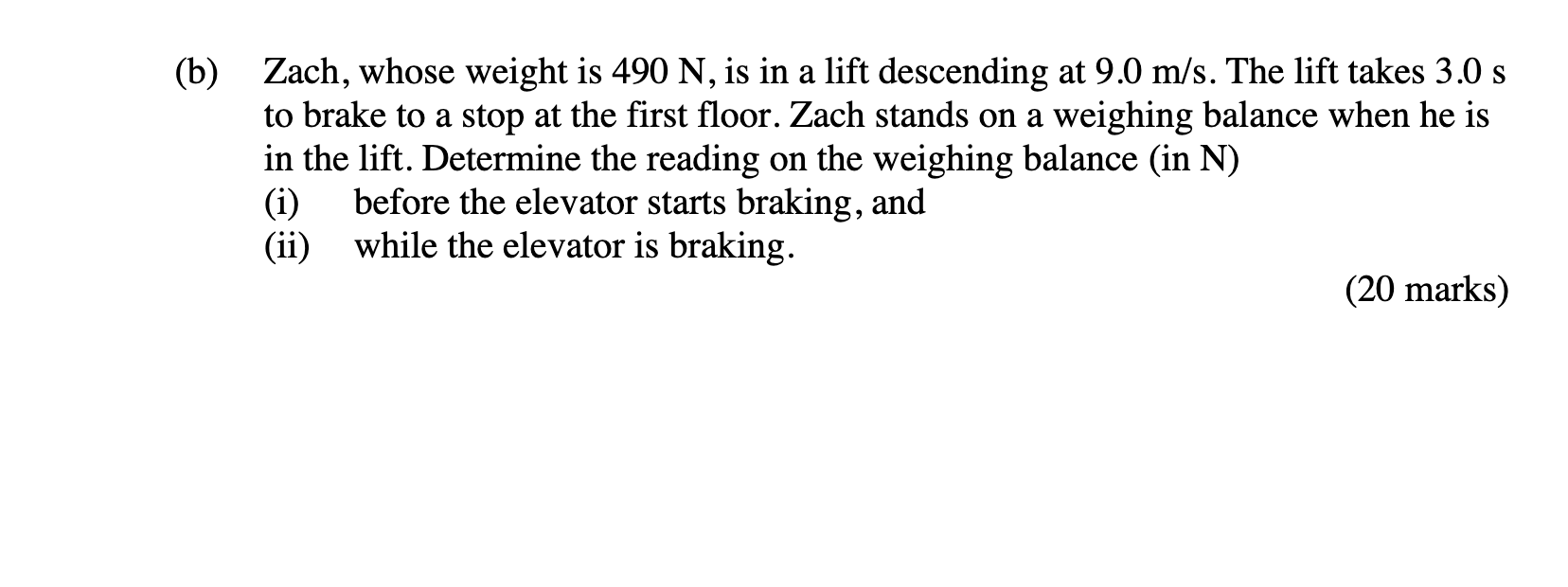Zach, whose weight is 490 N, is in a lift descending at 9.0 m/s. The lift takes 3.0 s to brake to a stop at the first floor. Zach stands on a weighing balance when he is in the lif... Zach, whose weight is 490 N, is in a lift descending at 9.0 m/s. The lift takes 3.0 s to brake to a stop at the first floor. Zach stands on a weighing balance when he is in the lift. Determine the reading on the weighing balance (in N) (i) before the elevator starts braking, and (ii) while the elevator is braking.

Understand the Problem
The question is asking to calculate the reading on a weighing balance in two different scenarios: (i) when the elevator is descending at a constant speed before it begins to brake, and (ii) during the braking process. This involves understanding the forces acting on Zach in relation to the lift's motion.
Answer
(i) \( 490 \, \text{N} \) (ii) \( 639.7 \, \text{N} \)
Answer for screen readers
(i) The reading on the weighing balance before braking is ( 490 , \text{N} ).
(ii) The reading on the weighing balance while braking is approximately ( 639.7 , \text{N} ).
Steps to Solve
-
Determine the forces acting on Zach while descending Zach's weight can be represented as $W = mg = 490 , \text{N}$. Since he is in an elevator moving-down at constant speed, the net force acting on Zach is zero. The weighing balance will read his weight.
-
Calculate the reading on the balance before braking Since the elevator is descending at a constant speed of $9.0 , \text{m/s}$, the acceleration ($a$) is $0 , \text{m/s}^2$. The effective force (reading on the balance) is simply Zach's weight: $$ R = W = 490 , \text{N} $$
-
Determine the deceleration during braking The elevator takes $3.0 , \text{s}$ to come to a stop from $9.0 , \text{m/s}$. We can find the acceleration using the formula: $$ a = \frac{\Delta v}{t} = \frac{0 - 9.0}{3.0} = -3.0 , \text{m/s}^2 $$
-
Calculate the reading on the balance while braking While the elevator is braking, the effective weight (reading on the balance) will be: $$ R = W - ma $$ Using $W = 490 , \text{N}$ and $a = 3.0 , \text{m/s}^2$, we can find ( m ) (mass of Zach): $$ m = \frac{W}{g} = \frac{490}{9.81} \approx 49.9 , \text{kg} $$
Now substitute ( m ) in the effective reading: $$ R = 490 , \text{N} - (49.9)(-3.0) $$ $$ R = 490 , \text{N} + 149.7 , \text{N} \approx 639.7 , \text{N} $$
(i) The reading on the weighing balance before braking is ( 490 , \text{N} ).
(ii) The reading on the weighing balance while braking is approximately ( 639.7 , \text{N} ).
More Information
Understanding the forces acting on Zach when the elevator is descending and when it is braking is critical. When the elevator descends at constant speed, the forces balance out, resulting in a reading equal to Zach's weight. During braking, Zach experiences an additional force due to the deceleration of the lift, causing the reading on the balance to increase.
Tips
- Miscalculating the acceleration during braking: Ensure to correctly apply the formula for acceleration based on the change in velocity over time.
- Forgetting to convert weight into mass when needed: Remember that ( W = mg ), so you need to find ( m ) before applying forces.
AI-generated content may contain errors. Please verify critical information